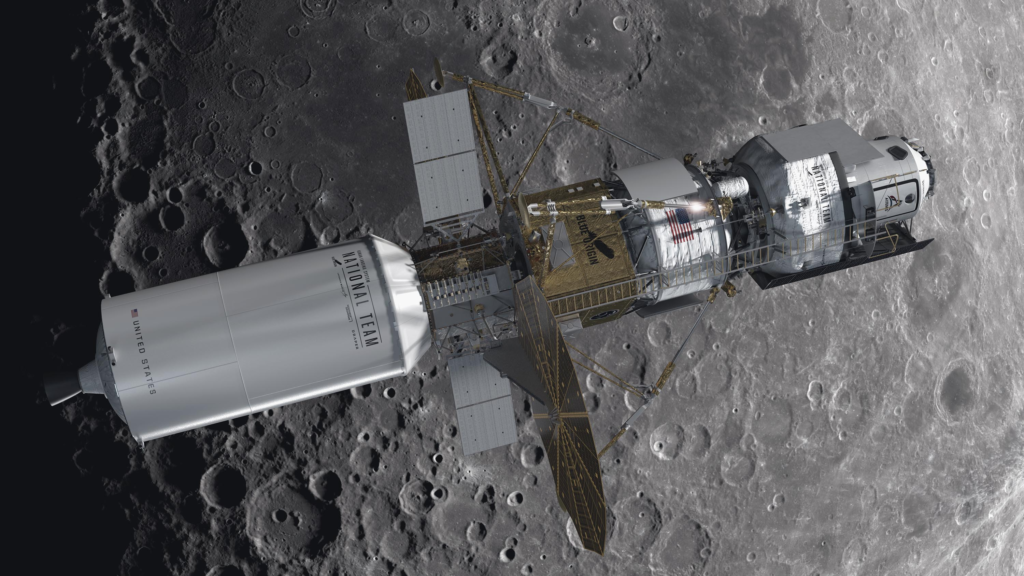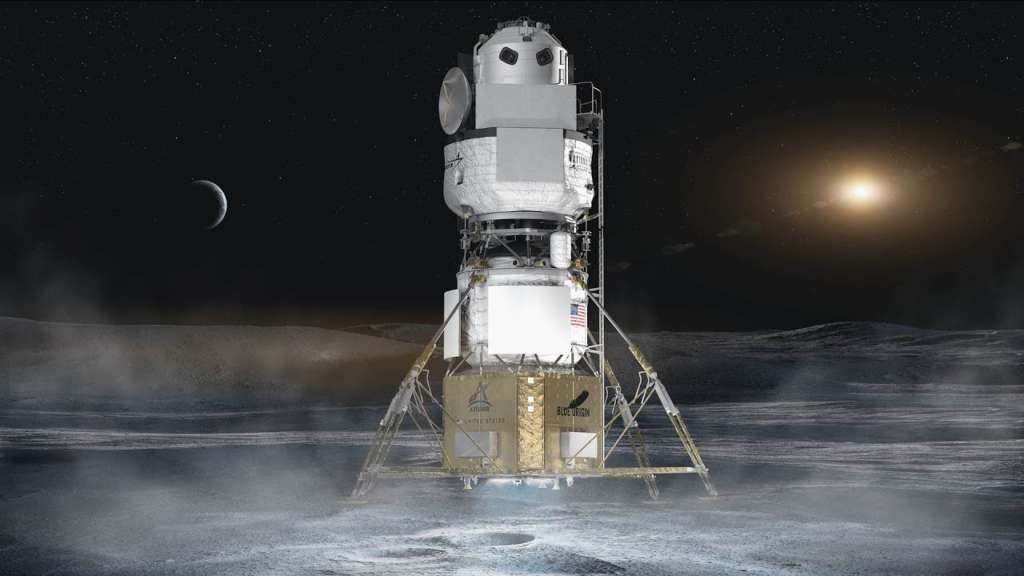
A Second Chance For Blue Origin’s Lunar Lander
Back in April 2021, NASA selected SpaceX as its partner to land the next American astronauts on the lunar surface. This initial competition was between SpaceX, Blue Origin who was in charge of the national team, and Dynetics. Fortunately for the company, the agency announced plans to create additional opportunities for commercial companies to develop an astronaut Moon lander.
Under this new approach, NASA asked American companies to propose lander concepts capable of ferrying astronauts between lunar orbit and the lunar surface for missions beyond Artemis III, which will land the first astronauts on the Moon in more than 50 years. Now in early 2023, Blue Origin and its modified team are trying again to create and demonstrate that they have the best option available.
Most significantly, SpaceX is not among the bidders this time around with Starship already having been picked earlier. This means one less company and group to compete with which goes heavily in Blue Origin’s favor. Here I will go more in-depth into Blue Origin’s new team, the lunar lander, what to expect in the coming months, and more.
Blue Origin’s Team

Originally, the National Team was led by Blue Origin and included Draper, Northrop Grumman, and Lockheed Martin. This time around, Northrop Grumman has left to work with Draper instead, and Boeing, Astrobotic, and Honeybee Robotics have joined the team.
The big news first came out early last year when NASA announced there would be a second opportunity for different human landing systems. The agency is pursuing two parallel paths for continuing lunar lander development and demonstration, one that calls for additional work under an existing contract with SpaceX, and another open to all other U.S. companies to provide a new landing demonstration mission from lunar orbit to the surface of the Moon. This upcoming second contract award, known as the Sustaining Lunar Development contract, combined with the second option under SpaceX’s original landing award, is hoping to pave the way to future recurring lunar transportation services for astronauts at the Moon. As far as progress, Blue Origin announced on Dec. 6th that it submitted a proposal for NASA’s Sustaining Lunar Development (SLD) competition. The announcement coincided with NASA’s deadline for SLD proposals.
The last HLS bidding process in 2020 through 2021 had some issues. NASA initially planned to include at least two companies for landings. But in April 2021, the agency chose SpaceX alone, out of concerns about not having enough budget available, according to officials at the time. Blue Origin and Dynetics protested the contract change and added claims of irregularities in the bidding process. After those concerns were overturned by the U.S. Government Accountability Office, Blue Origin launched a lawsuit in the Court of Federal Claims on Aug. 13, 2021; that court is in place to hear cases against the U.S. government, and months later, it ruled in NASA’s favor.
The reason these landing systems are so important has to do with their future application. The Human Landing System (HLS) will be a mode of transportation that will take astronauts to the lunar surface as part of the Artemis program. The program is managed at Marshall Space Flight Center in Huntsville, Alabama. Crews will board the HLS in lunar orbit and descend to the surface where they will collect samples, perform science experiments, and observe the lunar environment before returning to orbit in the HLS. Artemis missions are uniquely focused on expanding our knowledge of and establishing a long-term human presence on and around the Moon. To achieve these goals, NASA is looking at landing sites around the South Pole, establishing a lunar orbiting platform called the Gateway, and increasing surface expedition durations. Human landing systems of the Artemis era will need to be equipped to meet the challenges of complex missions. Required capabilities include docking with multiple systems, landing in a range of geographic regions, and acting as a crew habitat on the surface for the duration of early expeditions. All of which NASA considers when making its decision.
Lunar Lander Changes

Now that we know more about the new contract and Blue Origin’s team, we can take a closer look at the new lander the company is working on and any details we know. So far, Blue Origin hasn’t disclosed any details about its proposed lander or the roles its partners would play. The company instead emphasized the national aspect of its team, with suppliers in 48 of 50 states, excluding only Nebraska and North Dakota.
While not ideal, there will no doubt be a lot of similarities to the past design which we have quite a bit of information on. In addition, the official NASA document going over the pros and cons of each HLS system highlights what the company needs to change this time around. Starting with the technical approach, the report was quoted saying, “As an initial matter, I note that the Source Evaluation Panel (SEP) did not identify any significant strengths within Blue Origin’s technical proposal. Nonetheless, Blue Origin’s proposal has several attractive technical attributes. Within Technical Area of Focus 1, Technical Design Concept, the SEP evaluated Blue Origin’s proposal as having two strengths and two significant weaknesses that I find to be particularly notable. First, the SEP assigned Blue Origin a strength for exceeding certain functional and performance requirements for its initial demonstration mission. Some of these include a landed cargo capacity of 850 kg, meeting NASA’s goal for this requirement and thereby offering flexibility for manifesting equipment to support science and EVA operations.
Having an increased loiter capability in near-rectilinear halo orbit, enabling additional flexibility for SLS and/or Orion launches. Exceeding the threshold number of EVAs, allowing for additional flexibility when planning for surface exploration activities and science return; and meeting the goal value for vertical orientation, which will enhance internal operations and improve safety and quality of life for the crew during the surface stay. I agree with the SEP that these proposed capabilities not only exceed NASA’s stated requirements, but do so in a manner that would be materially advantageous to NASA in numerous ways during Blue Origin’s performance of its demonstration mission.
However, they went on to say, “But despite these and other strengths of Blue Origin’s technical design, I find that it suffers from a number of weaknesses, including two significant weaknesses with which I agree. The first of these is that Blue Origin’s propulsion systems for all three of its main HLS elements (Ascent, Descent, and Transfer) create significant development and schedule risks, many of which are inadequately addressed in Blue Origin’s proposal. These propulsion systems consist of complex major subsystems that have low Technology Readiness Levels (TRLs) and are immature for Blue Origin’s current phase of development. Additionally, Blue Origin’s proposal suggests that its Ascent Element’s engine preliminary design reviews and integrated engine testing occur well after its lander element critical design reviews, indicating a substantial lag in development behind its integrated system in which the engine will operate. This increases the likelihood that functional or performance issues found during engine development testing may impact other, more mature Ascent Element subsystems, causing additional schedule delays.”
“Further compounding these issues is significant uncertainty within the supplier section of Blue Origin’s proposal concerning multiple key propulsion system components for the engine proposed for its Descent and Transfer Elements. The proposal identifies certain components as long lead procurements and identifies them in a list of items tied to significant risks in Blue Origin’s schedule. Yet despite acknowledging that the procurement of these components introduces these risks, Blue Origin’s proposal also states that these components will be purchased from a third party supplier, which suggests that little progress has been made to address or mitigate this risk. At Blue Origin’s current maturity level, component level suppliers for all critical hardware should be established to inform schedule and Verification, Validation, and Certification approaches, and major subsystems should be on track to support the scheduled element critical design review later this year. Nevertheless, these attributes are largely absent from Blue Origin’s technical approach.”
These quotes from NASA’s report put into perspective some of the main issues they found with the system. It also represents the exact areas the company and its partners will be focusing on to ensure they win this time around. Hopefully, for Blue Origin’s case, this lengthy feedback and more time will allow them to provide a very realistic and future-proof HLS option.
Conclusion
Blue Origin and the National Team are trying again with some slight changes. This includes the departure of Northrop Grumman and the addition of a few other companies. While Blue Origin hasn’t shared much information regarding its new lander, there are various things we can infer based on past problems. We will have to wait and see how it progresses and the impact it has on the space industry.
